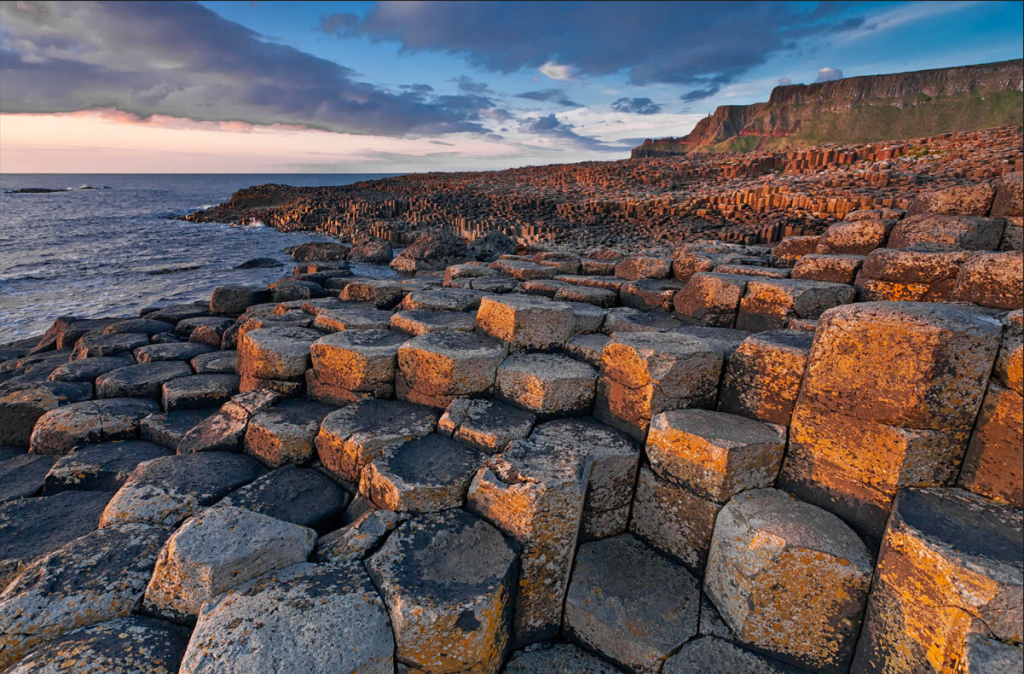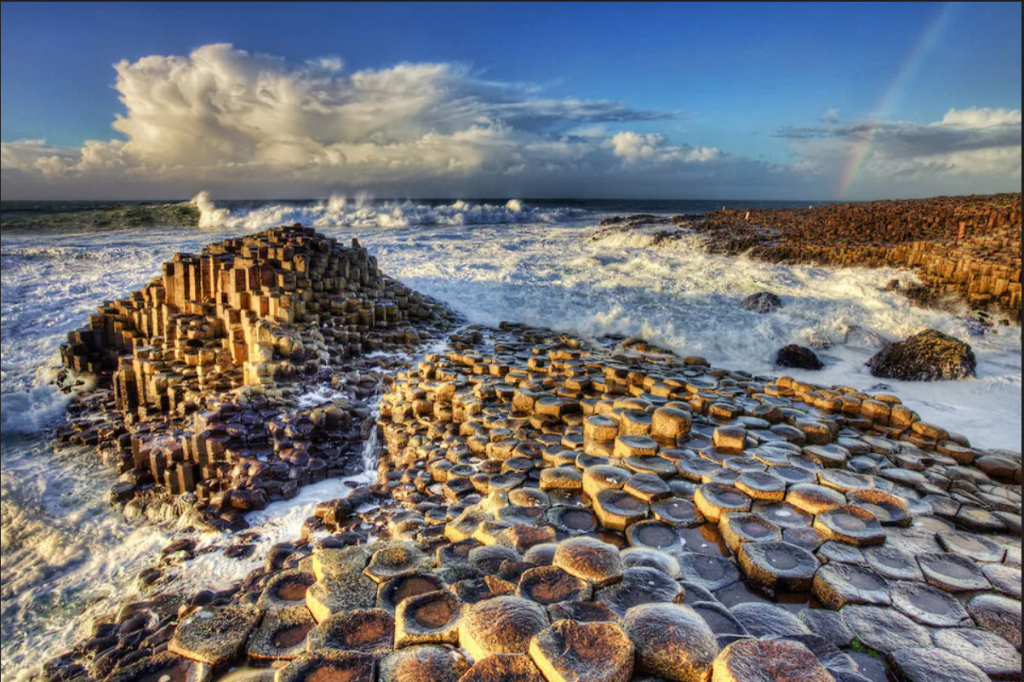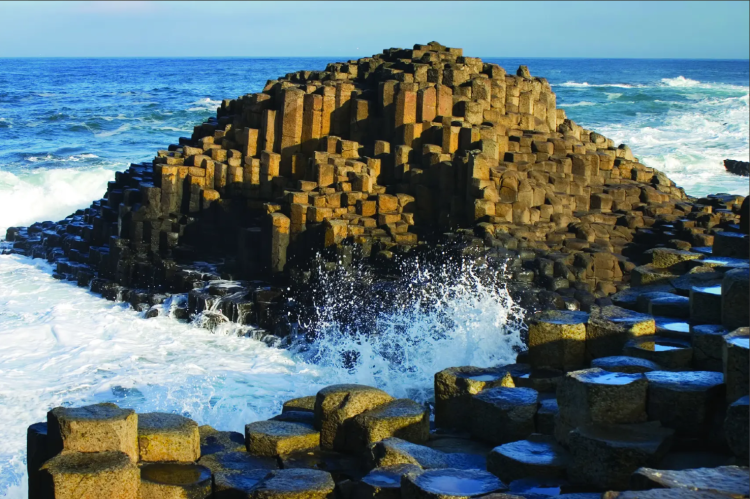About 80 kilometers northwest of Belfast, Northern Ireland, on the Atlantic coastline, is a stunning natural wonder, the Giant’s Causeway. The causeway, which stretches for thousands of meters with tens of thousands of basalt columns of uneven size, is not only a masterpiece of nature, but also a source of human culture and imagination. Listed by UNESCO as a World Natural Heritage Site in 1986, the Giant’s Causeway has attracted countless tourists, scholars and explorers, becoming a well-known tourist destination in Northern Ireland and around the world. This paper will introduce the Giant’s Causeway from multiple dimensions such as background, history, geographical location and characteristics, and analyze its influence and significance in tourism, culture and economy.
- Background and History of Giant’s Causeway
1.1 Geographical location and natural environment
The Giant’s Causeway, located on the north coast of County Antrim, Northern Ireland, is located on a headland on the edge of the Antrim Plain, extending along the foothills of the coastal cliffs. This region has a temperate maritime climate, four distinct seasons and abundant rainfall, providing unique natural conditions for the formation of the Giant’s Causeway. The coastline here twists and turns, and the waves constantly wash the rocks on the shore, forming a unique and spectacular landscape.
1.2 Geological origin
The formation of the Giant’s Causation dates back to the Tertiary period, about 50-60 million years ago, when the area was volcanously active. Streams of hot basalt melt out of cracks in the earth’s crust, flow to the sea, encounter cold water and quickly cool and solidify, forming solid basalt. Due to the shrinkage and crystallization of the lava as it cooled, combined with the long-term erosion of the waves, the regular polygonal columns that we see today were eventually formed. Most of these pillars are hexagonal, there are also quadrilateral, pentagon and other forms, cross-section width between 37 to 51 cm, height from sea level to more than ten meters, arranged in an orderly, spectacular.
1.3 Legends and myths
In addition to its scientific geological origins, the Giant’s Causeway is also rich in folklore and mythology. Legend has it that in ancient times, Irish giant Finn McCool fought a duel with Scottish giant Finn Gale. In order to cross the sea to Scotland, McCoole cut countless stone columns, filled the sea floor, and paved a causeway to Scotland, the Giant’s Causeway. However, when McCool returned home to rest and prepare for the next day’s decisive battle, Gale went to the Causeway ahead of him to check on the enemy. Gail, alarmed at the size of the sleeping McKool, mistakenly thought his father would be even larger, fled back to Scotland and destroyed the causeway, leaving only the remnants of what we see today. This legend has added a bit of mystery to the Giant’s Causeway, attracting countless tourists to explore the story behind it.

Second, the characteristics and charm of the Giant’s Causeway
2.1 Unique natural landscape
The Giant’s Causeway is famous for its unique group of basalt pillars. These stone columns are of different sizes, regular shapes, and arranged in an orderly manner, as if they were artificially carved. In the sunlight, the black basalt reflects the dazzling light, which is in sharp contrast to the blue sea, forming a stunning natural picture. As the seasons and weather change, the scenery of the Giant’s Causeway takes on a different look: fresh green in spring, blue sky in summer, golden yellow in autumn, and white snow in winter, all of which make it a paradise for photographers.
2.2 Abundant geological information
The Giant’s Causeway is not only a model of natural landscape, but also an important object of Earth science research. Through long-term research, geologists have revealed the formation process of these stone pillars and the history of geological changes. Natural forces such as volcanic eruptions, cooling lava, and ocean wave erosion conspired to shape this spectacular scene. The existence of Giant’s Causeway provides us with precious materials to understand the early history and geological activities of the Earth, which is of great significance to promote the development of earth science.
2.3 Diversified ecological landscape
In addition to the spectacular group of stone pillars, there is also a rich ecological landscape around the Giant Road. It is one of the habitats for Marine life in the Atlantic Ocean and visitors have the opportunity to see basking sharks, seals, dolphins and other Marine life. At the same time, it is also a paradise for many birds, and birds such as cormorants and puffins thrive here, bringing tourists a different kind of natural experience. In addition, the grasslands, forests and other natural landscapes around the Giant’s Causeway also provide tourists with a good place to relax.
Third, the influence and significance of the Giant’s Causeway in tourism, culture, economy and other aspects
3.1 Promotion of tourism
As one of Northern Ireland’s most famous tourist attractions, the Giant’s Causeway attracts tens of thousands of visitors each year. These tourists not only bring considerable economic income to the local area, but also promote the development of related industries. Tourism supporting facilities such as accommodation, catering and transportation have been continuously improved, providing tourists with a more convenient and comfortable travel experience. At the same time, the Giant’s Causeway has also become an important part of the Northern Ireland tourism brand, increasing the visibility and influence of the region.
3.2 Cultural inheritance and promotion
The Giant’s Causeway is not only a natural attraction, but also an important part of Irish culture. Rich in folklore and mythology, it offers visitors an important window into Irish culture and history. Through Tours and explanations, visitors can learn more about the legends of the Irish giants as well as the historical changes and cultural heritage of the region. The inheritance and promotion of this culture not only enhances the tourists’ sense of cultural identity and belonging, but also promotes the international communication and exchange of Irish culture.
3.3 Improvement of economic value
The Giant’s Causeway, as a World Heritage site and a famous tourist attraction, brings significant economic value to Northern Ireland and the UK as a whole. On the one hand, the development of tourism directly drives local employment and economic growth; On the other hand, through the protection and management of the natural heritage resources of the Giant’s Causeway, it also promotes the improvement of the local ecological environment and sustainable development. In addition, the Giant’s Causeway has become a proud cultural symbol and spiritual sustenance for local community residents, enhancing community cohesion and a sense of belonging.

Iv. Practical cases demonstrate the unique charm and attraction of the Giant’s Causeway
4.1 Visitor experience sharing
Many tourists have left a deep impression and good memories after visiting the Giant’s Causeway. They were shocked by the spectacular natural scenery here and attracted by the rich cultural legends, and they said that the trip was worthwhile. Some tourists share their travel photos and feelings on social media, attracting more people’s attention and yearning; Some visitors learn more about Irish culture and history by participating in local tourism activities and cultural experiences. The sharing and experience of these tourists not only enriched the tourism cultural connotation of the Giant’s Causeway, but also further enhanced its popularity and attractiveness.
4.2 Scientific research and cooperation
As one of the important objects of earth science research, the Giant’s Causeway has attracted many domestic and foreign scholars to investigate and study. Through field exploration, sampling and analysis, they revealed the geological origin and evolution history here. At the same time, it also carries out cooperation and exchange activities with scientific research institutions in other countries and regions to jointly promote the development of earth science. These scientific research activities not only provide scientific basis and technical support for the protection and management of the Giant Causeway; It also promotes the development of international academic exchanges and cooperation.
4.3 Ecological protection and sustainable development
In order to protect and manage the Giant’s Causeway as a natural heritage resource and promote its sustainable development, the local government and related agencies have taken a series of measures. They have established strict protection laws and management systems; Strengthen the guidance and supervision of tourist behavior; At the same time, the protection and restoration of the surrounding ecological environment have been intensified. Through the implementation of these measures, the natural landscape and ecological environment of the Giant’s Causeway have been effectively protected and improved; It has also laid a solid foundation for the long-term development of local tourism.
V. Conclusion and prospect
As one of the famous natural wonders and cultural symbols in Northern Ireland and even the world, the Giant’s Causeway has important influence and significance in tourism, culture and economy. It not only offers visitors a unique natural landscape and cultural experience; It also promotes the development of local tourism and the prosperity of related industries; At the same time, it also provides valuable information for the research and development of earth science. Looking forward to the future, with the continuous improvement of people’s awareness of natural heritage protection and the continuous development of tourism; We have reason to believe that the Giant’s Causeway will be more brilliant and dazzling glory! At the same time, we also hope that more people can personally enter this magical land to feel its unique charm and profound cultural heritage!





















